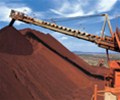
Asian iron ore prices are set to continue to face downward pressure from Chinese steel output curbs and power shortages in the fourth quarter after a dramatic price correction in Q3.
The iron ore index IODEX fell 46% in Q3 as widespread steel output curbs in China forced mills to resell contracted iron ore volumes, flipping the market into oversupply. However, different types of ore fared differently in the falling market, not only due to their own supply-demand dynamics but also external factors such as surging coke prices in China.
S&P Global Platts observed 88 spot deals for mainstream medium-grade fines from the top three miners Rio Tinto, BHP and Vale in Q3, slightly lower than the 91 observed in Q2, with a drop in spot sales from Rio Tinto partially offset by an increase from BHP.
Rio Tinto sold 18 spot cargoes of Pilbara Blend Fines, or PBF, in Q3 more than halving from 41 in Q2. BHP sold 59 spot cargoes of medium-grade fines — Newman High-Grade Fines (NHGF), Mining Area C Fines (MACF) and Jimblebar Fines (JMBF) — up from 38 in Q2 and 33 in Q1, as South Flank continued to ramp up production even as Chinese demand deteriorated.
Vale’s spot sales of Brazilian Blend fines remained stable at 3-4 spot shipments per month.
As prices collapsed and selling pressures mounted in Q3, miners moved from brokerage platforms to more flexible sales channels. Although spot sales decreased, Rio Tinto awarded nine strip tenders of PBF in Q3, more than the six strips it sold over the first half of 2021, while BHP sold more spot cargoes via open negotiations in Q3. Such sales channels allow sellers to get a full picture of all the bid levels before deciding whether to award the cargoes.
As the market became increasingly oversupplied, premiums for medium-grade fines brands fell sharply — even the most liquid brand PBF saw its premiums against the front-month IODEX drop from $13.35/dmt in July to around minus $1.30/dmt by mid-September.
Surging spot supply from BHP amid weak demand in September caused a correction for its lower-Fe medium-grade brands. JMBF and MACF saw their widest discounts against the front-month 62% Fe indexes in the past three years, at minus $21.90/dmt and minus $15.90/dmt respectively in mid-September, although the discounts had narrowed somewhat by the end of the quarter.
Steeper discounts for lower-Fe medium-grade fines
The steeper discounts for lower-Fe medium-grade fines also stemmed from the rising penalties from impurities such as silica and alumina as coke prices soared in September, which explained why the higher-Fe brands such as PBF, NHGF and BRBF saw relatively resilient premium levels.
Iron ore brands with high silica such as CSN’s IOC6 fines also saw discounts widening as end-users sought to reduce coke rates through the utilization of lower-silica ore. CSN sold a cargo of IOC6 fines via tender in mid-September at minus $30/dmt against the average of IODEX over the month after arrival, a sharp fall against an earlier cargo sold late August at minus $15.50/dmt against the average of IODEX over the month after arrival.
Vale sold less spot Carajas Fines, or IOCJ, in Q3, but more non-mainstream products. Vale’s spot sales of non-mainstream products, the bulk of which was high-silica fines, increased as early as Q2. This is in contrast with 2020, when its spot sales of non-mainstream products only surged in Q4.
Vale’s customers were advised that the quality of its high-silica fines, which are used to make Brazilian Blend Fines, or BRBF, by blending with IOCJ, deteriorated. As a result, a higher ratio of IOCJ was needed in the blend to maintain the quality of BRBF.
Meanwhile, production ramp-up in Vale’s Northern System, where IOCJ is produced, was heard to have been slower than expected. The two developments could be the drivers behind the tight supply of IOCJ and early surge in spot sales of high-silica fines. In addition to the runaway coking cost in China, the increased supply of high-silica fines into China also fueled the rise in silica penalties in Q3.
High silica penalties constrain high-grade supply
However, since September, Vale has reduced sales of high-silica fines. Firstly, the IODEX corrected sharply on the back of steel production curbs and power rationing in China. Meanwhile, high-silica iron ores were still heavily penalized due to the expensive coke prices. In addition, the freight rate from Brazil to China continued to rise, averaging $35.85/wmt in September. All these factors made selling high-silica fines alone uneconomical for Vale, market participants said.
As supply of high-silica ores has already decreased, the direction of silica penalties will largely hinge on the coke prices in the coming months, sources said, adding that changes in steel margins and the extent of sintering and steel production curbs in winter could also change mills’ tolerance levels of impurities in ore.
Source: Platts





